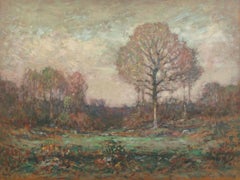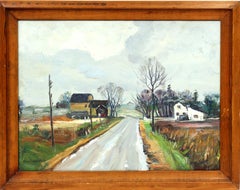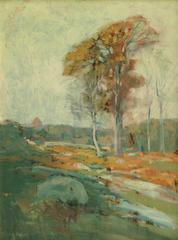Henry Cooke White Landscape Paintings
Henry Cooke White in Hartford, Connecticut. His career in art was founded at the age of 14 after meeting the famous American Tonalist painter, Dwight William Tyron. The two became lifelong friends, and White even wrote Tyron’s major biography, The Life and Art of Dwight William Tyron (published in 1930). In the late 1880s, Tyron pushed White to move to New York City to further his artistic training at the Art Students League. During this time, White studied under many talented artists including Kenyon Cox, John H. Twatchman and William Merritt Chase. From 1896–97, White spent time traveling in Europe. Upon his return to the states, he began to spend most of his time in Connecticut, following his favorite painting seasons. Spring in Hartford was followed a week later by spring in Old Lyme, and then finally at Waterford. He would experience his favorite seasons three times over each year. Once immersed into Connecticut’s community, White was encouraged to paint habitually in Old Lyme where an art colony was developing, beginning in the spring of 1903. Inspired by European artists, including Claude Monet, and Pierre Auguste-Renoir, the Old Lyme Art Colony defined American Impressionism by memorializing the serene qualities of rural New England life through the use of vibrant palettes and broken strokes on wood and canvas. The Colony comprised upwards of 200 artists during its three decades of creating nature-based scenes in oils and pastels such as Frederick Childe Hassam, Willard Metcalf and Henry Cooke White amongst the rest. Henry C. White had come to be known for his paintings, pastels and etchings of the Connecticut landscape. The Old Lyme Art Colony has been described as one of America’s most distinguished art colonies. In 1910, he founded the Connecticut Academy of Fine Arts and stayed active with the group until late in his life. He continued to paint into his early 80s and died during his 91st year in Waterford in 1952.
Mid-20th Century American Impressionist Henry Cooke White Landscape Paintings
Canvas, Oil
Early 20th Century American Impressionist Henry Cooke White Landscape Paintings
Canvas, Oil
Late 19th Century American Impressionist Henry Cooke White Landscape Paintings
Canvas, Oil
1950s American Impressionist Henry Cooke White Landscape Paintings
Oil, Canvas, Illustration Board
1970s American Impressionist Henry Cooke White Landscape Paintings
Canvas, Oil
21st Century and Contemporary American Impressionist Henry Cooke White Landscape Paintings
Canvas, Oil
Late 19th Century American Impressionist Henry Cooke White Landscape Paintings
Canvas, Oil
1920s American Impressionist Henry Cooke White Landscape Paintings
Oil, Canvas
1990s American Impressionist Henry Cooke White Landscape Paintings
Canvas, Oil, Illustration Board
1950s American Impressionist Henry Cooke White Landscape Paintings
Canvas, Oil
1970s American Impressionist Henry Cooke White Landscape Paintings
Canvas, Oil
1970s American Impressionist Henry Cooke White Landscape Paintings
Canvas, Oil
Late 20th Century American Impressionist Henry Cooke White Landscape Paintings
Canvas, Oil
Mid-20th Century American Impressionist Henry Cooke White Landscape Paintings
Oil



